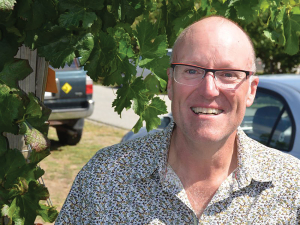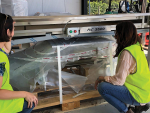Vaughn Bell on pest management, biosecurity, and some insights into the future of viticulture
I first met Vaughn Bell a few years ago when we co-presented at Spray Days. His deep knowledge and engaging style on vineyard pest and disease management always stood out to me, so I finally took the opportunity to sit down with him for this issue’s biosecurity article.
After more than two decades in entomology, Vaughn has become integral to New Zealand’s viticultural research landscape. Based in Hawke’s Bay and working for Plant & Food Research (soon to be renamed), Vaughn has spent 21 years studying the intricate relationships between pests, crops, and the environment – with a particular focus on mealybugs and the viruses they transmit.
His journey into entomology began unexpectedly. “I was 35, doing a botany and ecology degree at Victoria University of Wellington,” he recalls. “One of the papers introduced me to biological control, and it just clicked. I didn’t even know that was a thing.” That spark led to a master’s degree and eventually a full-time role in research, where he’s remained ever since.
Mealybugs, viruses, and the hitchhiker problem
Vaughn’s work has primarily centred on pip fruit and wine grapes, where mealybugs pose a persistent threat. “They’re a common denominator in both crops,” he explains. “And they’re classic hitchhiker pests – easily transported on harvesters and leaf trimmers from one vineyard to another.”
The implications are serious. Mealybugs can carry Grapevine Leafroll Virus, and it only takes one infected insect to transmit the disease to a healthy vine. Vaughn emphasises the importance of machinery and equipment hygiene. Cleaning down before and after working in the vineyard to stop the spread of pests like mealybug and weevil is essential.
Climate change and pest pressure
Climate change adds another layer of complexity. “We currently see two to three generations of mealybugs per growing season,” Vaughn notes. “But with warming, we could see a partial fourth. More generations mean bigger infestations – and if early-season sprays aren’t effective, things can spiral quickly.” Sudden weather events like Cyclone Gabrielle also disrupt ecosystems, making pest management even more unpredictable. “I won’t be around to see the worst of it, but I’d love to know what the world looks like in 30 or 50 years,” he says.
Unsung heroes: beneficial insects
Biological control remains a cornerstone of Vaughn’s personal and professional philosophy. Yet the biology and ecology of many beneficial insects – parasitoids, spiders, lacewings, earwigs – are poorly understood. “We know they attack many of our pest species, but we don’t know how effective they are,” he says. “And our vineyards can be hostile environments. If these insects don’t stay, they can’t exert the control we need.” Flowering plants like buckwheat and borage can help, but continuity of bloom is key. “Beneficial insects need energy, longevity, and stable habitat. And we need to understand their biology better – especially the predators, which are harder to monitor than parasitoids.”
Technology and the future
Despite the challenges, Vaughn is optimistic about the role of technology. “Smart traps with cameras and artificial intelligence can identify insects in real time. That’s huge. You can pinpoint problem areas in your vineyard without collecting and individually inspecting thousands of leaves.” He sees a generational shift underway. “Younger growers want efficiency. They want to use their phones and computers. And rightly so – it’s the future.” Still, he cautions against abandoning traditional methods. “There’s something important about walking your vineyard, seeing what’s happening. Technology will enhance that, not replace it.”
Practical advice for growers
Vaughn’s final message for growers is to take nothing for granted. “Train yourself and your people well so you and they know what you’re looking for and at – what mealybugs look like, what leafroll virus looks like, and how to differentiate it from nutrient deficiencies.”
He stresses the importance of integrated pest management: using softer chemistry, applying them correctly, and maintaining equipment. “Sprayer maintenance sounds basic, but it’s critical – nozzle alignment, water volumes, tractor speed, all of it.”
Above all, invest in your staff. “Let them feel confident to speak up if they see something odd. It might be nothing — or it might be a new pest incursion. That kind of vigilance is what keeps our vineyards healthy.”





